Arturia’s V-Collection 9 is more than just another “add some more instruments, update a few things” V-Collection refresh. This one goes somewhere new and dreamy – both with new instruments that aren’t remakes of old stuff, and some of the biggest advancements coming in the form of rebuilds for some of your favorites.
And I do mean dreamy. If I’m late in turning in my review, it’s that I found myself on some sonic reveries I didn’t expect with this one. I’ll explain – as you do need to really dig in to appreciate why this is a bigger landmark than a typical year.
https://www.arturia.com/products/software-instruments/v-collection/overview
Compatibility. You don’t have to update to V-Collection 9 just to get support for Apple Silicon, by the way – that update came free in 8.2 to owners of that release. So this is really about whether the new instruments and rebuilds give you creative possibilities. (Of course, if you did get a new Apple machine and have something earlier than V-Collection 8, it’s a no-brainer.) Backward compatibility on both platforms is impressive – Windows 8.1+ for PC folks and macOS 13 High Sierra.
8.2 also delivered tuning support for Clavinet V, Stage-73 V, Piano V, and DX7 V. Now the same tuning support is in all the new instruments, too (including the reboot of the Piano V). That means these are perfect software instruments to use with MTS-ESP and other tools.
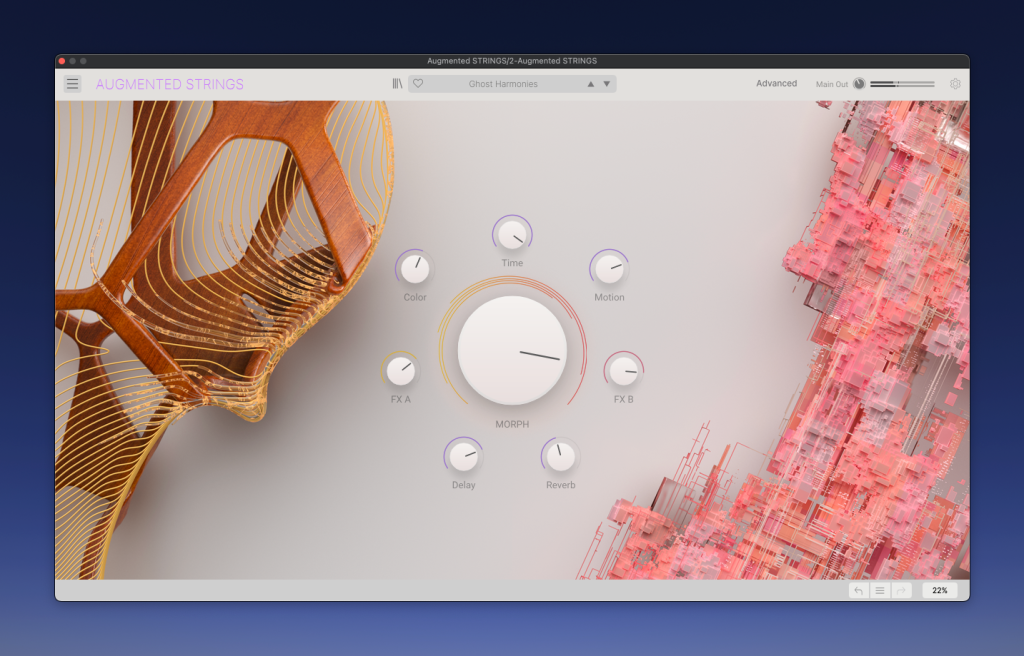
New augmented instruments
Augmented STRINGS and Augmented VOICES are perhaps what is most interesting in this update because they take the toolset in a new direction. Since the start, V Collection has been essentially about recreations of classic instruments – the “V” even stands for “virtual.” Arturia has certainly packed a lot of additional twists into those recreations – think enhanced modulation and effects, among other features – but they still emulate something from the past.
Augmented VOICES and STRINGS are really something new and imaginative, hybrid instruments combining multiple techniques and morphing to produce something truly otherworldly. And for me, just having these in the collection starts to make me think of the other instruments in new ways.
Arturia’s FX Collection has been going in similar territory. After the usual EQ and dynamics gear, we’ve started to see Arturia-original delays and reverbs. These can still bring in components of modeling from real-world circuits and other details grounded in historical hardware but in entirely unheard-of combinations. And then there was a particular favorite of mine (and anyone into granular stuff), Efx FRAGMENTS:
The “Augmented” range builds on FRAGMENTS – even with its functionality baked in – to produce ethereal, dreamy new textural soundscape-makers. STRINGS and VOICES can be realistic if you like, but they really benefit from cranking up the parameters and bending them into beautiful, warped timbres.
Here’s a play, adding some Ableton Microtonal and – because I just can’t get enough of the granular stuff, Efx FRAGMENTS from FX Collection layered on top of the patch I dialed in with VOICES and STRINGS.
Both engines are all about layering – with a full spectrum of sounds Arturia describe as “realistic to abstract.”
The basic notion –
- Per-engine sample or synthesis base. Synths and samples can be layered together for synthetic-acoustic hybrids.
- Altered samples. Various creative tools based on voice and strings (for the respective library), ready for assembling in other contexts. The parallels to what Arturia has done with their PIGMENTS synth are clear.
- 2 layers. You can really thing of this as two-engine, two-part multi-timbral mayhem, each a thick stack on its own. Each engine-level layer then has its own filter, effects, and two layers of your choice (synth/synth, synth/sample, sample/sample).
- Macro controls. These are useful not only for the presets, but your own creations, because you can quickly perform with morphing, etc. And you can (and should) always use this in conjunction with the Advanced mode. Morph, Time, Color, Motion, FX A, FX B, Reverb, Delay.
- Modulation – lots of it. 2 LFOs, 2 function generators, 2 random generators, 4 keyboard modulation sources, and dedicated vibrato and tremolo.
- Effects – lots of that, too. 2 FX slots per layer, 14 FX, including EQ, bitcrushing, the BL-20 Flanger from the FX Collection, and more.
- 16-step arp.
- Delay and Reverb. 5 total algorithms, lots of possibilities. And I put it together with the FX Collection, because of course I did.
- MPE and MTS-ESP ODDSOUND compatible. So polyphonic expression and tuning support.
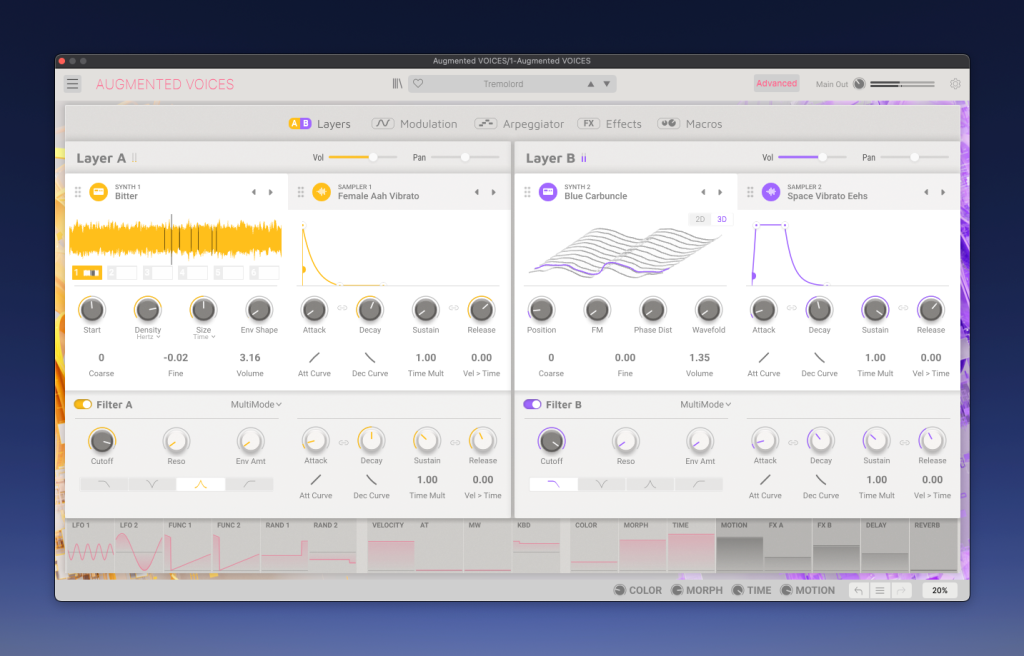
This is way more than a novel one-off; there are a ton of engine features inside. The synth engines cover virtual analog, additive synthesis, wavetable, and granular engines, on top of all the sounds.
It’s all really exciting. The basic idea reminds me a lot of the early Output instruments and effects, but it’s totally Arturia in vibe now – and frankly a lot easier to navigate. Diving into a preset and messing around with some layers gives you immediate customization, so it’s often comfortable to do that rather than start from scratch – though there are templates, too, to help you out.
And importantly, it’s all eminently playable. It’s one of the few instruments where I right away use the macros for myself, not just for presets – and you’ve got MPE and MIDI modulation so it’s instantly useful with an instrument.
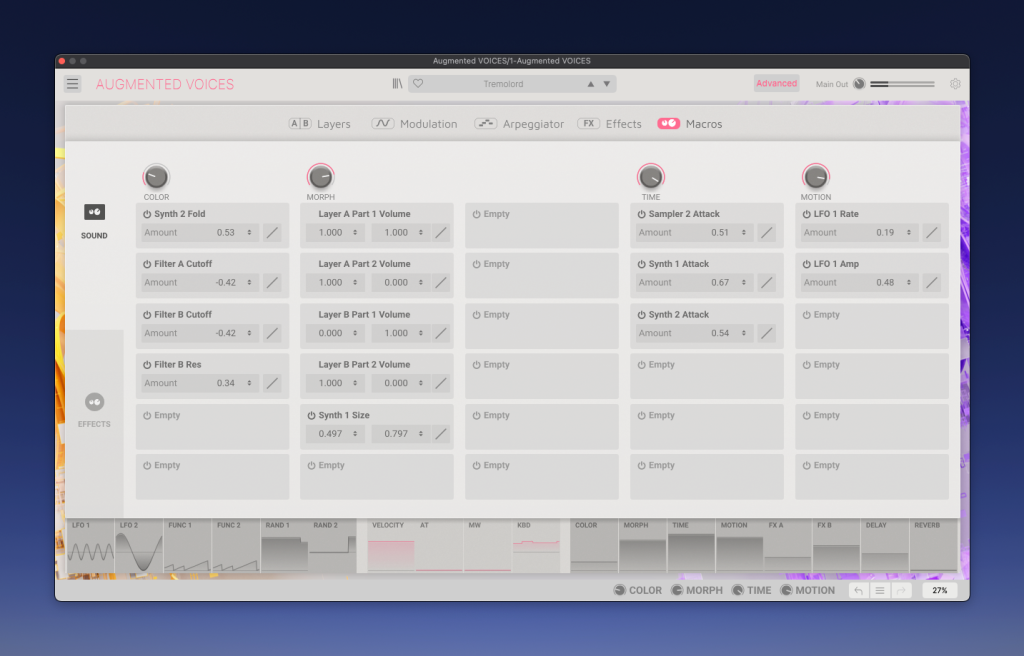
I may make it sound like these instruments are interchangeable; they do have the same basic architecture. But they’re pretty nicely differentiated as far as sound content and character inside, though you absolutely can make the string instrument sound like vocals and vice versa in a nice way.
On the vocal side, you get solo and ensemble recordings, close and far mic arrangements, and various articulations, plus enough pre-processing that this sounds different than what you’d get out of a run-of-the-mill vocal sample library even before you start messing with layering, modulation, and effects.
Strings, too, cover solo and ensemble, close and far mics, articulations, and double bass, cello, viola, and violin. (Okay, version 2.0 wish – viola da gamba!)
The fact that the engines are so similar means you might not buy each a la carte, but they’re a wonder as far as consistency since you only have to learn the UI once.
More on these two:
https://www.arturia.com/products/software-instruments/augmented-voices/overview
https://www.arturia.com/products/software-instruments/augmented-strings/overview
More new instruments
The big “classic” addition for V 9 is the Korg MS-20 V. That’s one that needs little introduction – it’s just a tremendously versatile, gorgeous instrument. And Arturia worked directly with KORG on this one, producing what I think is the most convincing-sounding software yet – and I do have the KORG re-make of the MS-20 next to it for comparison.
KORG MS-20 V
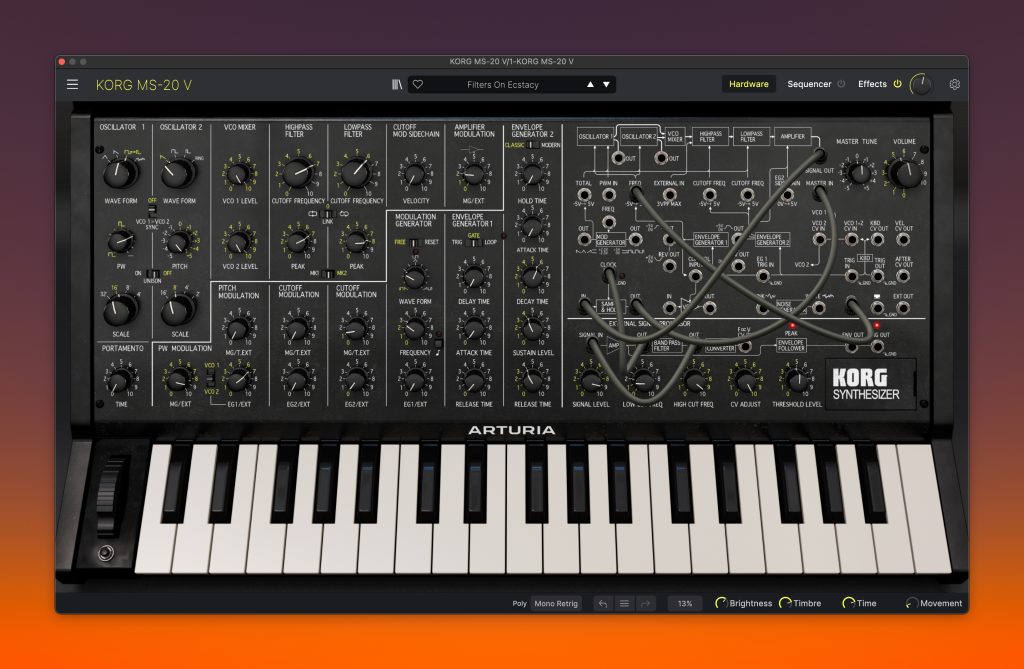
It’s so good, that it’s better to talk about what Arturia added. And first, it’s nice to see an MS-20 in software form with a usable UI. But there are other additions, too:
The big one is, you get a modeled SQ-10 sequencer in the software. I mean, if you’re going to be using an MS-20 now, you might as well use the distinctive companion sequencer, too – very usable here. (Usable enough that you might want to work out making a simple DIY controller for it!)
3 channels, 12 steps. (Yes, 12 – part of that distinctive KORG sound; you have enough 16-step or 8-step sequences, anyway!)
And this being an Arturia instrument, of course, there are four FX slots, with 18 possible FX – just as we’ve seen on other recent additions.
MPE – check.
MTS-ESP – check.
Expanded polyphony – 6-voice, with Unison mode.
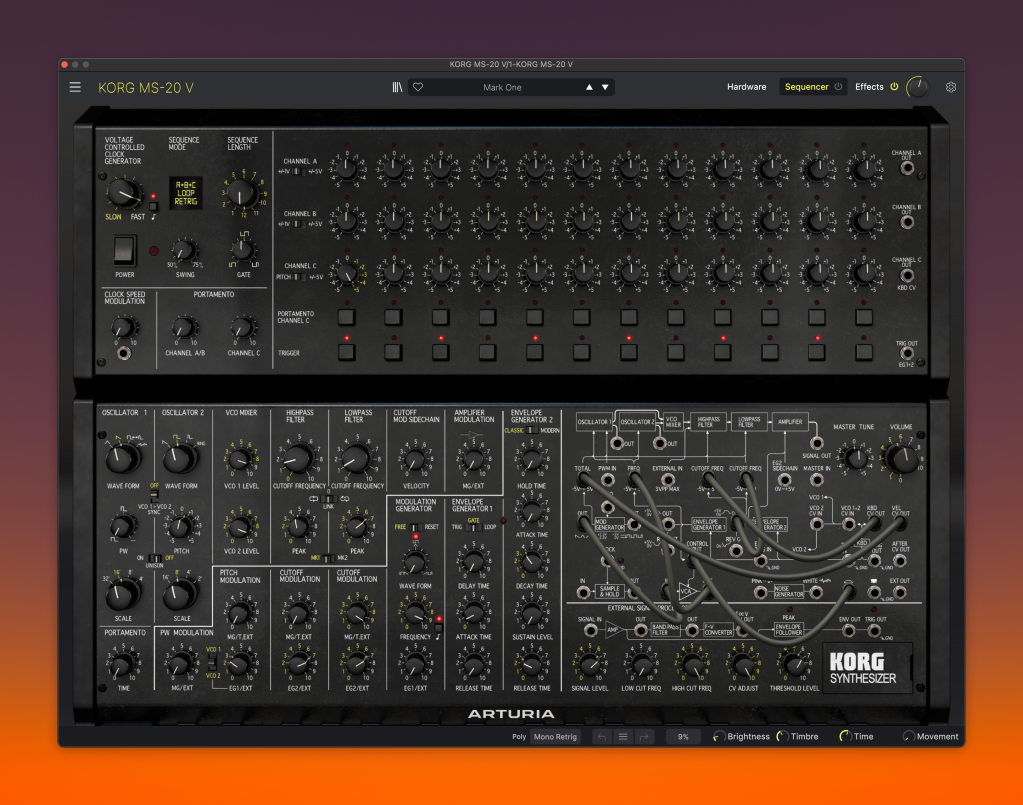
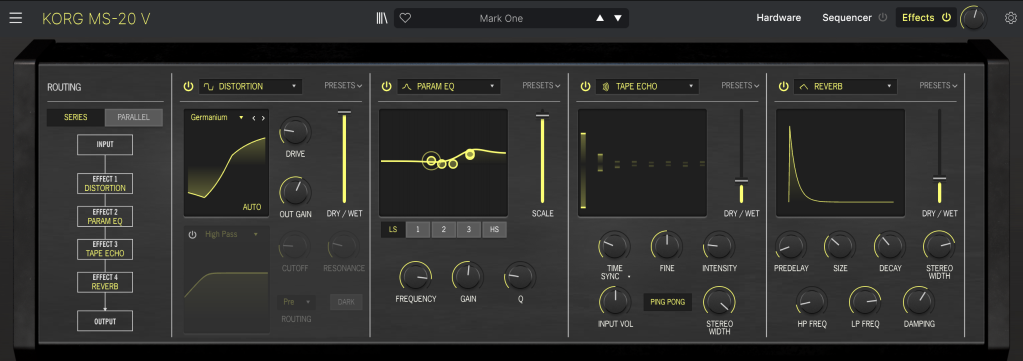
Other than that, it’s an MS-20, with all the things that are great on an MS-20 – frequency modulation, hard sync, ring mod, some work really modeling those KORG IC-35 and OTA chips, the envelope generators, everything. And of course, it’s eminently patchable – this is one of the best semi-modular synths ever made, and even though it was created in 1978, it holds up. (I hope the same can be said of me.)
Oh, another thing that might not be obvious – you can use this as an effects processor. There’s the External Signal Processor module, just as on the real hardware – so this may have just become the most useful effects processing plug-in in the V Collection, complete with Envelope Follower and sidechaining. Plus you can combine the MS-20 as effects processor with those 4 effects slots, and use those in either serial or parallel.
…this may have just become the most useful effects processing plug-in in the V Collection, complete with Envelope Follower and sidechaining.
More:
https://www.arturia.com/products/software-instruments/korg-ms-20-v/overview
The other new addition was already announced — the fabulous SQ80 V crosswave synth.
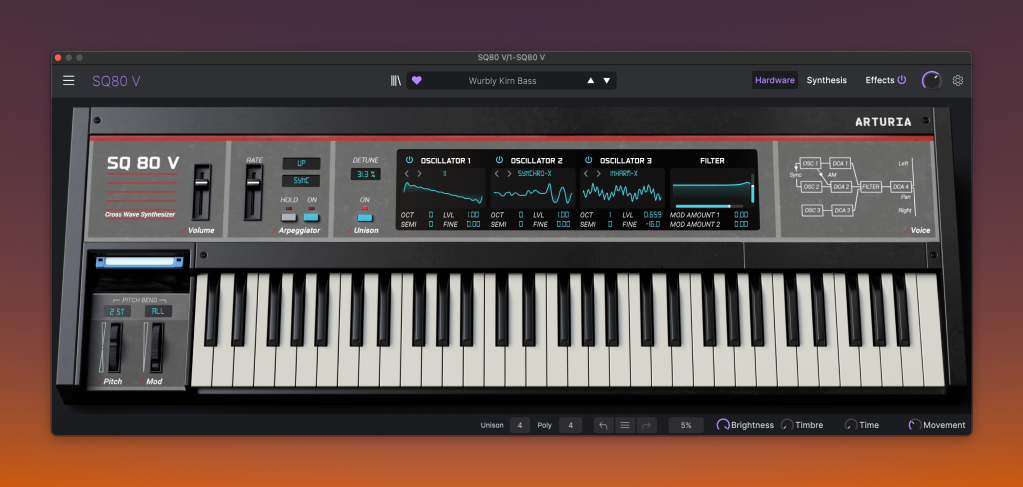
I can’t stop using this one, so I should just do a sound design guide to this and a couple of others.
SQ80 V
https://www.arturia.com/products/analog-classics/sq80-v/overview
But it’s easy to sum up. 8-bit oscillators, hybrid waveforms, layering, from the same engineers that designed the sound engine of the Commodore 64.
Look, you never need to have heard of an SQ80 – that’s just a genius combo in 2022, anyway. It’s perfectly modeled here – yes, because they have analog components, modeling a vintage chip does require effort – that together with the nicely-modeled analog filter gives it a wonderful, lo-fi thwonk. And then Arturia crammed it with more waveforms, added an 8-voice unison that’s so natural you’ll swear the original had it, an arpeggiator, voice dispersion to add additional organic qualities to the sound, and expanded the envelopes. (The original envelopes are there, but frankly a bit too limiting.)
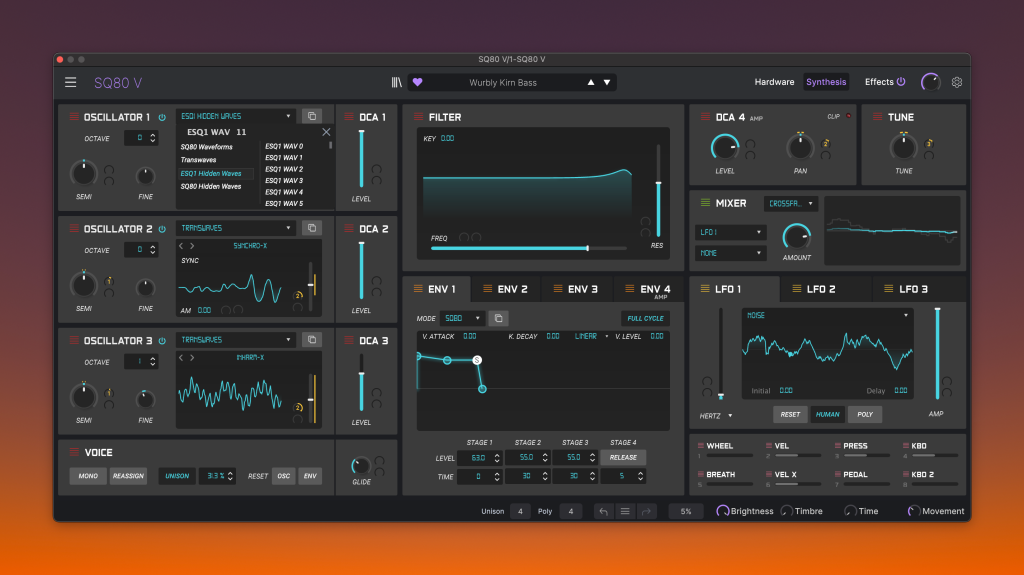
The upshot is – I realize I may be saying something blasphemous here, but I enjoy using the SQ80 V even more than Pigments. And it feels a bit like a retro Pigments from an alternative universe, like if it had been made by 80s Ensoniq, brought through a Bill & Ted time machine to work on a plug-in. (1989, right at the end of the SQ-80 lifespan – actually, that checks out. Maybe that is what happened. Dude.)
All the default presets, even “hidden” waveforms, are there for your choosing, and a ton more.
MPE compatible, though no MTS-ESP yet. Hoping that gets added as it has been to the others.
Rebuilt instruments
So, that’s the new stuff. But honestly, the thing that may make a lot of folks really want to upgrade is the number of instruments that have been rebuilt from scratch. (Some folks I know worked on the rebuilds – it sounds like a lot of work.) The ones I’ve played with in fact show a lot of work. V Collection always had the most instruments around. With these rebuilds, I think it’s arguably got the greatest depth and sound quality, too.
Let me focus on just two of those I’ve spent the most time on – Prophet-VS V and Piano V.
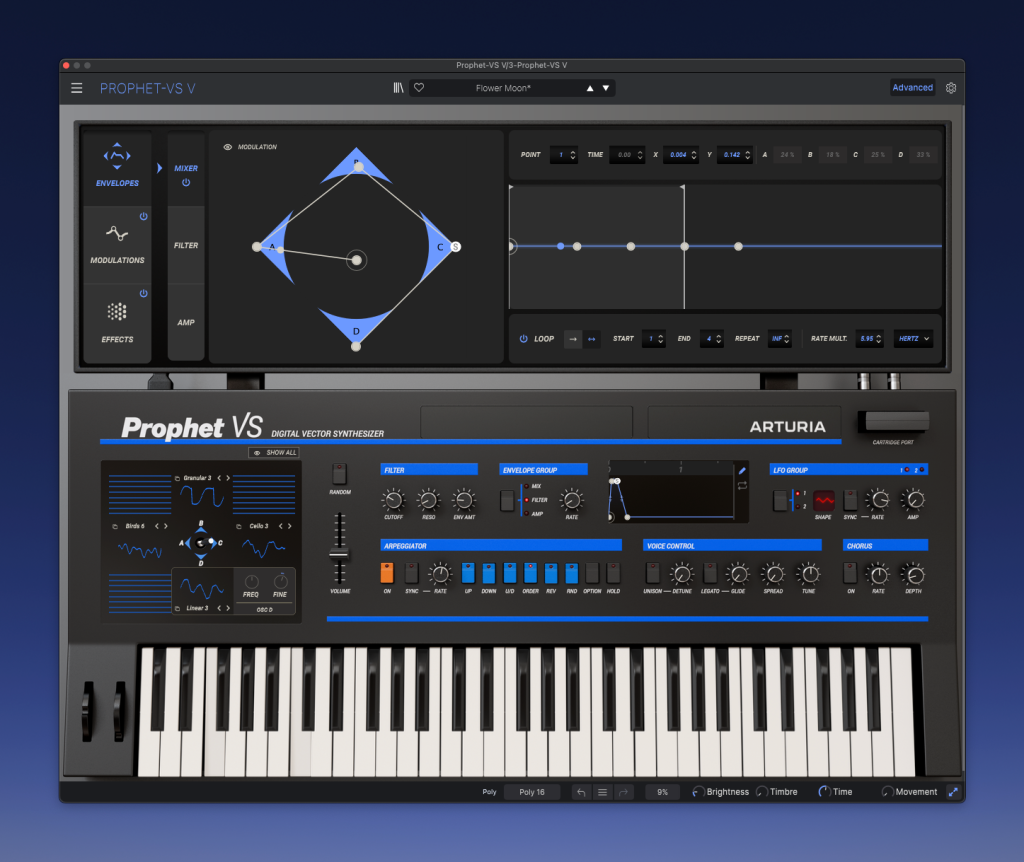
Prophet-VS
I began this story before the loss of Dave Smith, but this is a chance to experience some of his work from Sequential even if you can’t afford the vintage hardware or access to it. (These are unauthorized replicas, but thoroughly enjoyable – and of course do check out Sequential and Dave Smith Instruments hardware.) That’s especially true of the Prophet-VS, the ground-breaking “vector” synth – the instrument Dave made that changed the shape of digital synthesis via wavetables and morphing. It still feels futuristic – once in your hands, very much able to make sounds of now.
And this instrument is just wonderful. Alongside the SQ80 V, it’s become a go-to for me. It’s good enough to hold up alongside current wavetable instruments, especially with the niceties Arturia added.
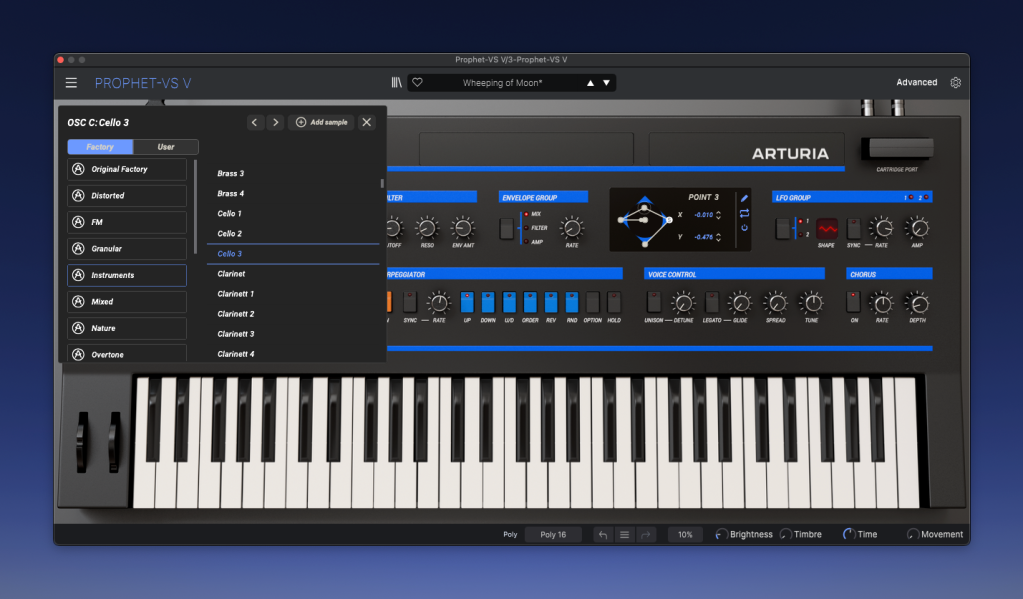
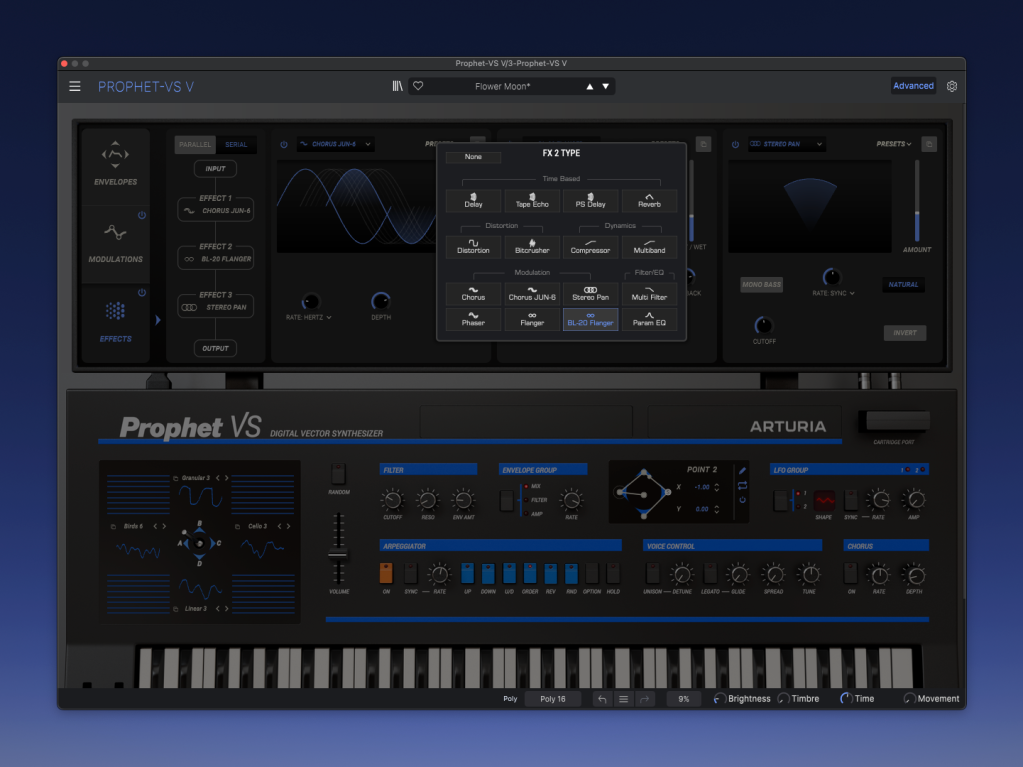
As on the Ensoniq instrument, it’s a perfect combination here – accurate models of the filter (and VCA), plus details you wish the original had (like additional envelope types). There’s also a modeled BBD chorus, and yes, this one also does MTS-ESP and MPE.
https://www.arturia.com/products/software-instruments/prophet-vs-v/overview
Piano V
Piano V is a gem, too, in the rebuild. I was never as sold on the original; this is the first one I really enjoy playing, especially with all the possibilities you can get out of “Advanced” mode.
I do absolutely recommend clicking out of the pretty picture of a piano in a gallery or living room and doing that, as there are tremendous, expressive controls that can make these instruments feel more realistic or more creative/experimental. I also think it makes loads of sense to turn off the aggressive Limiter, which tends to flatten the sound of the instruments too much. (I wish they’d included a ‘lock’ feature for that switch, as on dry/wet on the FX Collection.)
The re-built instrument here is absolutely worth a look. It’s the first time the Piano V for me has rivaled my other favorite, the all-modeled, not-sampled (so lighter on your hard drive) Modartt Pianoteq. Having the two together makes me fall in love with pianos all over again.
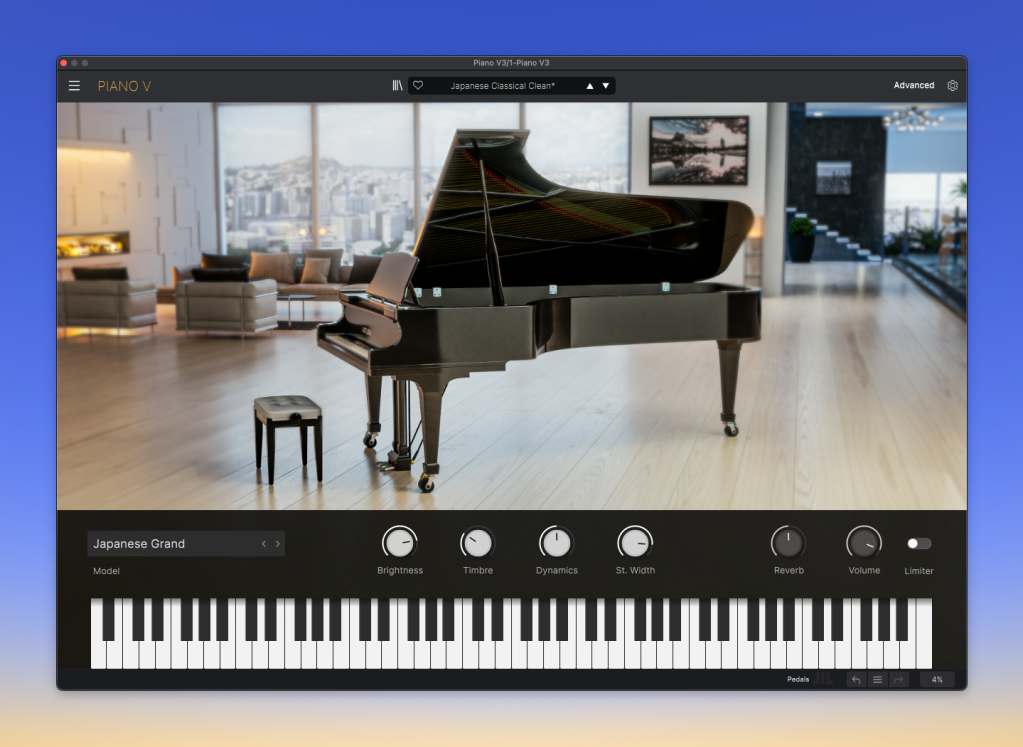
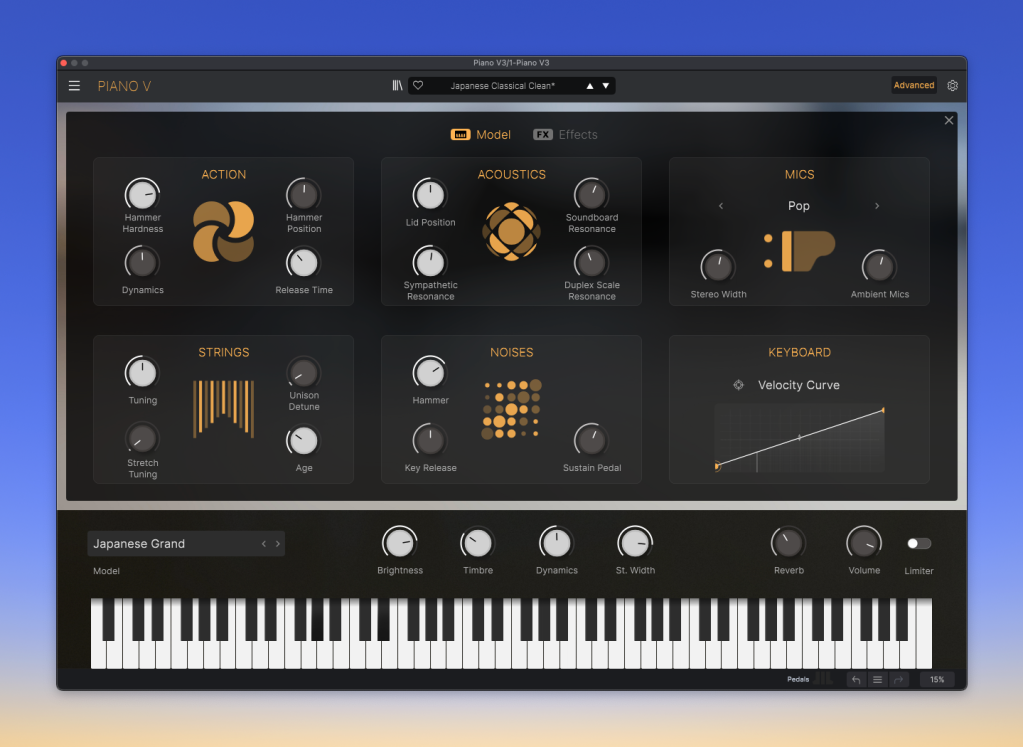
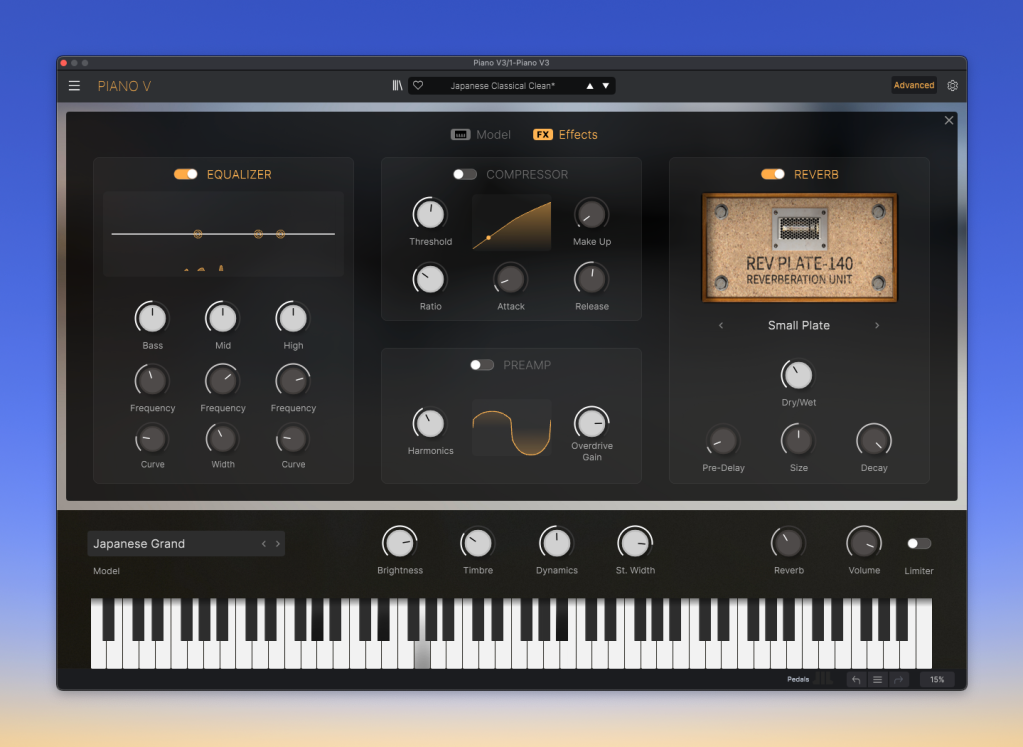
And as with some of those other instruments, you get controls for resonance, mic placement, a whole mess of different possible reverbs including Arturia’s excellent plates (but other environments, too), a compressor that I think you should use instead of that limiter switch, and more. You can also get a lot of lo-fi effects out of these pianos, as well as uniquely controllable detuning – of strings with one another, and of the whole instrument.
It’s actually the only instrument I’ve ever played that offers intuitive control from stretch tuning “the piano tuner just left the piano bench before a concert at Carnegie” to lots of detuning all the way to experimental / spaghetti western saloon / left in a building that was in a flood / whatever. And I do mean continuous – you can dial up exactly what you need really without knowing anything about tuning, or in some in-between spaces that you find intuitively.
Here’s a quick jam, with still more Efx FRAGMENTS (with CMI glitches enabled) and a subtle touch of Delay TAPE-201:
Conclusions
V Collection demonstrates the value of a pay-to-own suite, instead of something like a subscription. It’s really up to Arturia to give you reason to upgrade with that model – and this year, they really delivered. For retro lovers, the MS-20 and integrated SQ-10 are an easy sell – and KORG, for their part, continue to cement their beloved brand on every platform from DS to plug-in to short-run hardware.
But more than that, I appreciate that just as Arturia evolved from software to hardware and hybrid company, they’ve made the shift from virtual recreations to original instruments – and some compelling space in between. With all the extra waveforms, the SQ80 feels like a retro-tinged Pigments of sorts, or an SQ80+ if you prefer. The Piano V engine now really has come into its own as a physical modeling instrument. Full tuning and MPE support help bring software into the 21st century and support expression and inclusive musical practices in ways we’ve long anticipated.
And the Augmented series gives a tantalizing look at what’s possible with futuristic instruments. These digital creations benefit from a lot of the detail work done on modeling vintage instruments, so what we get are new hybrids.
It feels like just how you’d outfit a dream studio in hardware – just the right combination of old and new. With a little work to play these from Arturia’s own controller hardware or, even better, your favorite MPE-capable instrument, we’re spoiled in the search for new sounds.
Previously:
Videos
Some great videos here on how to navigate this stuff: